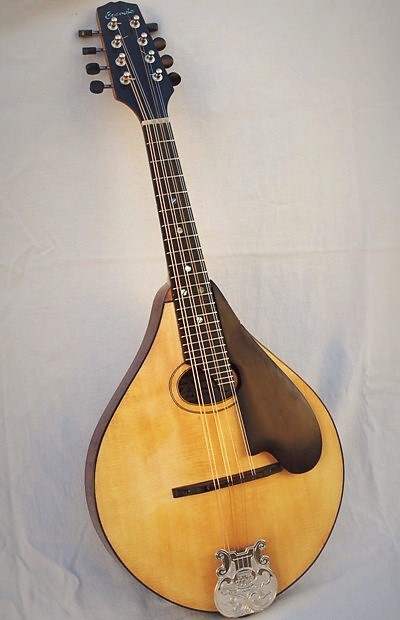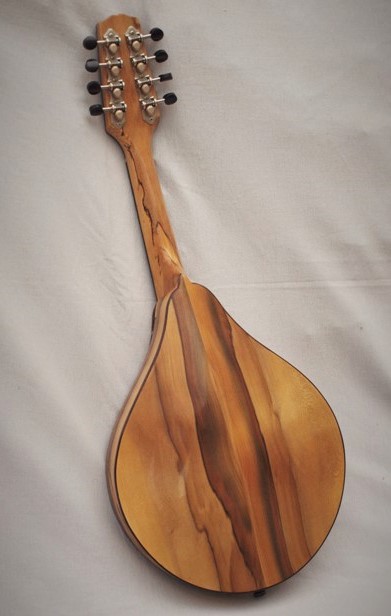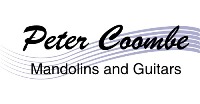Peter Coombe Mandolins and Guitars
Classical Mandolin
Based on the Lyon and Healy style A and style C
Description
Available as the Classical mandolin with symmetrical or
asymmetrical points, and as the Classical Junior with no
points and a Classical Flattop with or without points. There are two possible scale lengths, 13 3/4
inches or 13 inches.
These models are based on the Lyon
and Healy mandolins and they are constructed very similar to
the Lyon and Healy/Washburn mandolins. There are some
differences, primarily to keep costs under control. For
example, there is no scroll headstock, and the tailpiece is
simpler. There is no leg pin, but there is an end pin so
a strap can be used. It is named the Classical model
because the Lyon and Healy mandolins are very popular amongst
musicians who play classical music on mandolin. These
mandolins are my personal favorites. They sound similar
to the original Lyon and Healy mandolins, but are louder and
more responsive, and in my opinion the tone is also improved.
Fantastic mandolins, delightful to play and they sound
awesome, really sweet, I love them and get blown away every
time I string a new one up (but that is my opinion). The
two points are, however, significantly more work to make so
are more expensive. The Classical Junior is made to
reduce the cost, and they are built
the same as the Classical model, except there are no points
and they have a riser block to simplify the bindings, and a
full contact adjustable Brekke bridge.
The Lyon and Healy mandolins were constructed very
differently from the Gibson mandolins. Many makers claim
to make a mandolin "based on" on "influenced by" the Lyon and
Healy's, but in fact have nothing much in common apart from
the body shape. A Coombe classical model mandolin is in
fact based on and constructed similar to the original Lyon and
Healy, because I have studied the originals very closely. It has exactly the same feel and delightful
playability.
Sound - the sound of the carved top classical models are
quite different from my standard oval hole mandolins.
They have a lighter, brighter and more delicate sound and
feel. They do sound close to my original 1918 and 1924 Lyon and
Healys, but are louder, more lively and ring and sustain more.
Like the original, they do not have the big woofy bass that is
so characteristic of Gibson style oval hole mandolins.
The Classical Flattop mandolins are remarkably good sounding
for a flat top mandolin . The proof is in the sound
clips. I have spent much time researching how to make a
great sounding flat top mandolin, and with the third
generation of these mandolins that use some guitar
construction principles, have achieved the goal. They
are fun to play, sound really great, and are lighter and less
bulky than an arched top mandolin, and because the top is much
lighter, are quite a bit louder. This is a popular
model.
Update - the Classical Flattop mandolin is now
into it's 4th generation. They are now built similar to
a classical guitar, fan braced with a lightweight top and
heavy back so most of the sound comes from the top. The
changes to the bracing of the top have been a significant
improvement to the sound and also volume. The sound is a
little different, but on the same level as any of my carved
top mandolins so are great value.
Update - the
Classical Flattop mandolins are now available with points, but
only with a Spruce/Maple wood combination. These are
really special mandolins, something I am very exited about.
For more information see
specifications or
contact me.
Pictures of the
asymmetric Classical model, short scale length (13 inch).






